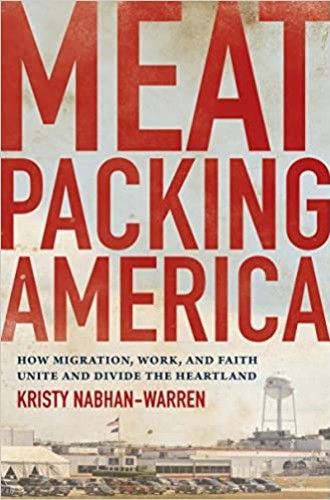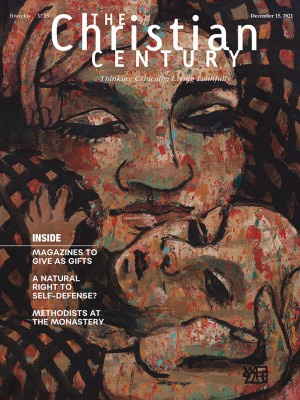The White Iowans and Latino and African migrants of the meatpacking industry
Kristy Nabhan-Warren’s ethnographic study complicates familiar views of the Corn Belt.
The heartland. Flyover country. The Corn Belt. The parts of rural America where the meatpacking industry thrives are dismissed by many people as a sea of red counties on election maps. Yet these small towns and villages are also where abstract debates about immigration, work, and faith put on flesh and blood—where migrants and refugees share packing lines and church pews with White, native-born Americans. In Meatpacking America, Kristy Nabhan-Warren destabilizes the often oversimplified view of the midwestern Corn Belt, focusing in particular on Iowa. She reveals a far more nuanced and layered story of how White Iowans and Latino and African migrants manage the shifting dynamics of American life.
Nabhan-Warren presents a series of ethnographic portraits that illuminate the role of work, faith, family, and food as common denominators in a seemingly divided America. She tells the stories of her encounters with migrants, White Iowans, priests, and meatpacking executives. She contends that their lived experiences give insight into the complexities of immigration, people’s desire to work, and the role of faith through it all. Drawing connections between the stories of past Europeans settling the frontier and migrants of today, Nabhan-Warren takes a “lived religion” approach, examining the ways religion functions in her subjects’ daily lives and inspires survival in often strenuous circumstances. In the Corn Belt, “religion lives in the fields, farms, and packing plants as much as in the churches,” and Nabhan-Warren’s conversations with Iowans reveal a deep connection between the land, agriculture, and personal faith.
Read our latest issue or browse back issues.
She focuses much of her narrative on the meatpacking industry, painting the Corn Belt as a modern “Ellis Island for asylum seekers and refugees” because “where there is meat, there is work.” Whereas the industry used to be urban-centric and dominated by Eastern Europeans, it has since shifted to small towns in right-to-work states like Iowa, with the majority of workers being of Latin American or African descent.
As the influx of migration has changed these small Iowa towns, local priests like Fathers Bernie, Joseph, Greg, and Rudy seek to serve a population of rapidly shifting demographics. Thus, they often must minister in both church spaces and workplaces, visiting parishioners for whom faith helps ease the trauma of working the line. Some companies, including Tyson, employ full-time chaplains like Joe Blay, a Ghanaian meatpacking chaplain who works to support his fellow migrants, praying with them amid the blood and offal of the plant. Blay and his fellow chaplains seek to make such grueling work manageable in a “profane place of slaughter.”
Nabhan-Warren’s conversations reveal a corporate environment in which both managers (usually White) and line workers (generally migrants of color) use language saturated with religiously tinged words, such as family, caring, faith, blessed, and fortunate. The face of religion in these plants is not exclusively Christian: at the end of long, hard days, workers “thank Allah, Jehovah, and Jesus for the work” that enables a better life for their families. At one plant, a group of Somali and Sudanese Muslim women craft a sacred space for prayer in a corner of the women’s locker room, complete with long drapes for privacy and regular cleaning to halt the ever-accumulating grime of the environment. The religiously diverse employees in meatpacking plants find common ground in the importance their faith plays in their lives, giving them meaning during their long hours on the line.
Nabhan-Warren is careful, however, to ensure that the brutal, violent, and grotesque reality of the work is not lost among these emotional and personal vignettes. She spent time observing work in the plants, and her graphic descriptions of it play a pivotal role in reminding readers of the visceral reality of what it means to “harvest,” break down, and package a hog or cow before it ends up on a supermarket shelf. Her horrific (but not gratuitous) account collapses the normal distance between the consumer and the butchering process, reminding readers that those who skillfully cut and package meat are vulnerable human beings balancing work, family, and faith.
While White Iowan settlers arrived in the 19th century to “plant corn and churches,” Latin American and African migrants today arrive to work in meatpacking plants and in the agricultural industry. For both, the Corn Belt’s copious job opportunities and low cost of living have been the key to accomplishing dreams of homeownership and stable employment. For both, newer generations—thanks to the hard work of their families—have been able to break the cycle of packing plant work, often going to college and pursuing jobs outside of Big Agriculture. With the help of their faith, their community, and their grueling, relentless hard work, migrants and refugees and White Iowans have built a home together in rural America.
Nabhan-Warren’s detailed conversations and experiences with people who live and work in the Corn Belt provide a window into the difficult yet fulfilling lives of rural Iowans. The stories she tells illustrate the wider cultural changes occurring throughout the United States. She effectively reveals a more nuanced picture than the diners full of Trump supporters shown on the news. Yes, there is racism, and there are anti-immigrant views. But inclusivity and intercultural relationships are also being cultivated in the small towns dotting the Corn Belt.
As the United States debates the question of who belongs here, Nabhan-Warren’s conversations with people actually working it out together on the ground give voice to those most affected by immigration policy debates. Further, she reveals a thread of faith running through both the lives of migrants and of native-born Americans, elucidating how their faith gives meaning in the blood-soaked world of meatpacking. Anyone interested in faith and work, immigration, American history, or even just a good story will find this to be a fascinating, emotional, and vitally important book. In its pages, abstract political debates break away in the face of the messier reality of migration as a new “religion of real life” is uncovered.
A version of this article appears in the print edition under the title “Faith amid the slaughter.”






